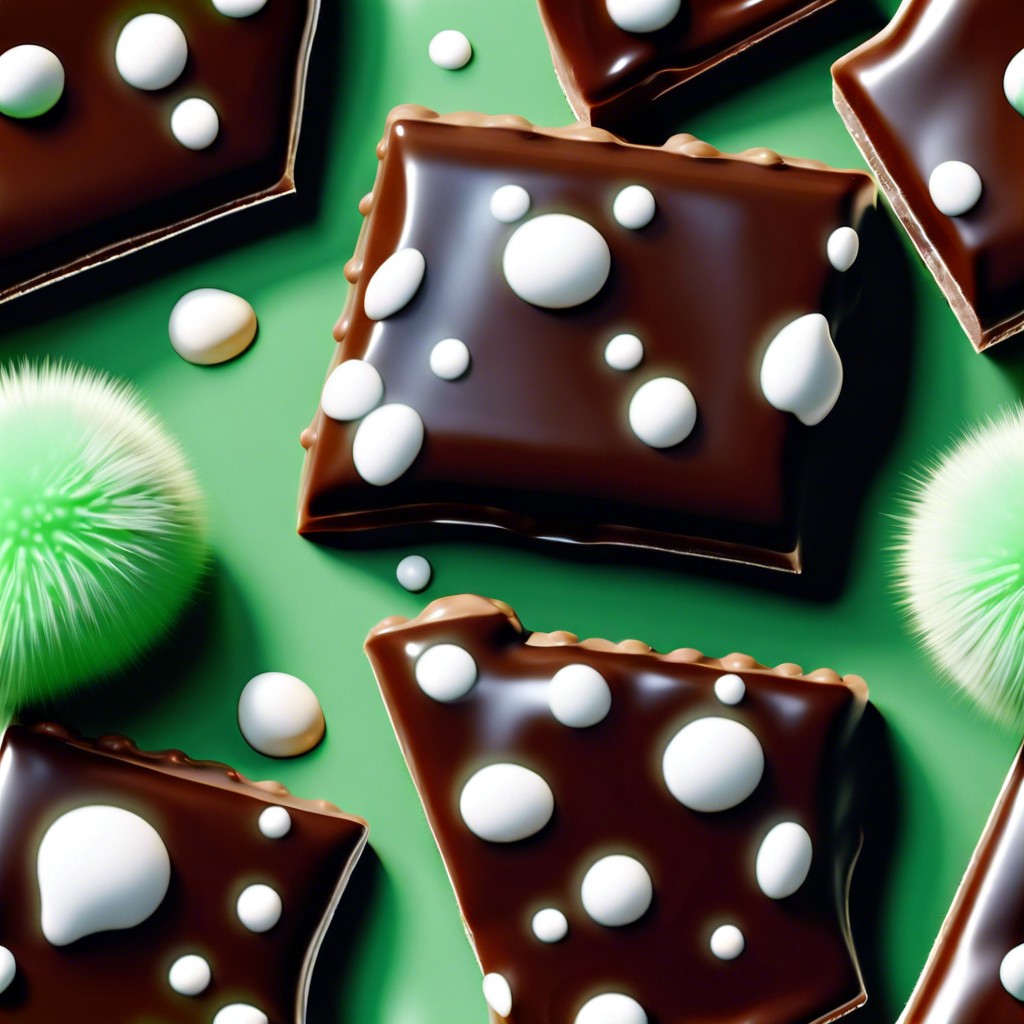Discover what causes mold on chocolate and how to prevent it from ruining your sweet treats.
Key takeaways:
- Mold on chocolate appears as fuzzy or velvety spots.
- White spots on chocolate may be fat or sugar bloom, not mold.
- Eating moldy chocolate can cause stomach upset and allergic reactions.
- Store chocolate in a cool, dry place with humidity under 50%.
- Use opaque containers, wrap chocolate tightly, and keep it away from strong odors.
Inside
Identifying Mold On Chocolate

Spotting the unwelcome guest of mold on chocolate doesn’t take a detective. Look out for fuzzy or velvety spots, often white, green, or blue in color. Unlike the harmless and typical whitish-gray streaks caused by temperature changes known as ‘bloom,’ mold declares its presence more boldly. It may appear slightly raised and sometimes carries a musty smell, a clear sign that it’s time to bid farewell to the affected treat. While visually inspecting, pay attention to any changes in texture that seem out of character for your chocolate’s usually smooth persona. If it looks sketchy or smells like last week’s forgotten leftovers, it’s a sure bet that mold has made its unwelcome move. Remember, trust your eyes and nose—they’re your best tools for sniffing out when something’s amiss with your sweets.
Differences Between Mold, Fat Bloom, and Sugar Bloom
White spots on your chocolate? Hold the panic button! It might just be your sweet treat showing its true colors – and I don’t mean mold. Chocolate can play dress-up in two other common costumes: fat bloom and sugar bloom.
Now, fat bloom is like chocolate getting a bit sweaty. Those white streaks or a grayish film appear when the cocoa butter separates from the cocoa, often from temperature swings. It might make your chocolate look like it hit the gym too hard, but it’s still good to gobble up.
Sugar bloom, on the other hand, is more like a sugary sprinkle. It happens when moisture gets friendly with your chocolate, dissolving some sugar on the surface. When the water says goodbye, it leaves behind a gritty sugar coat that could make you think of a white sand beach.
Neither fat nor sugar bloom are mold, which isn’t shy with its hues, showing off in green, blue, or even white fluff. It’s the uninvited guest that comes from inviting moisture to the party. When mold crashes your chocolate soiree, unlike its lookalike blooms, it’s time to bid that bar farewell, as it’s no longer safe to eat. Remember, chocolate’s wardrobe is diverse, but not every outfit is meant for the runway of your taste buds.
Health Implications of Eating Moldy Chocolate
If you bite into chocolate and find a musty surprise, take a step back. Mold can harbor toxigenic substances known as mycotoxins. These substances might upset your stomach or lead to allergic reactions in sensitive individuals.
Now, not all molds are villains in disguise; some are used in cheesemaking. But when it comes to chocolate, mold is definitely an uninvited guest. Think of it like this: Having mold in your chocolate is like finding an unwelcome critter at your picnic – it spoils the fun and might cause harm.
Remember, a little vigilance with your sweet treats can go a long way. Keep an eye out for any off flavors or strange colors. If your taste buds wave a red flag, it’s probably time to bid farewell to that chocolate bar. Your health deserves that respect. After all, chocolate is a delight, not a source of distress.
Strategies for Preventing Mold On Chocolate
To fend off the unsavory speckles of mold, consider the environment where you stash your chocolate. A cool, dry spot with a steady temperature between 65-70°F (18-21°C) spoils neither the taste nor texture. Humidity is a trickster that ushers in mold; maintain it under 50% for chocolate’s safe haven.
Getting chummy with airtight containers or resealable plastic bags will pay dividends in your fight against the fuzz. By barricading your treats from the outside humid air, chocolate can remain unblemished for longer.
For the long-term haul, the chilly embrace of a refrigerator works wonders. But wrap your chocolate in an additional shield – wax paper, foil, or cling wrap before tucking it into an airtight container. This combo fends off moisture and prevents the chocolate from absorbing any lingering fridge odors that could spoil the party.
Remember to give your chocolate some breathing room after its fridge stint. Let it return to room temperature before the grand unveiling to prevent condensation, keeping unwelcome mold at bay.
Adopt these tactics and you’ll side-step the need to say farewell to your favorite chocolate stash due to mold’s mischief.
Proper Storage Techniques to Avoid Mold
Chocolate lovers, take note: keeping your treats free from mold is simpler than you think. First up, cool is king. Chocolate thrives in a stable environment – think temperatures between 65°F and 70°F (18°C-21°C) and humidity below 50%. Warmer or more moist conditions invite unwelcome fuzzy guests.
Always opt for an opaque container for storage. Light, much like heat, can degrade chocolate quality, making it more susceptible to spoilage. Additionally, wrap chocolate snugly in foil or plastic. This is vital for two reasons: flavor preservation and preventing moisture from sneaking in—the archenemy of mold-free confections.
Last but not least, give your chocolate personal space – away from strong-smelling foods or cleaners. Chocolate absorbs odors like a sponge, and no one appreciates garlic-tinted truffles. By paying attention to these simple practices, you can save your sweets from an untimely moldy fate.
Related
- Can You Eat Expired Chocolate: Safe or Sorry?
- Does Chocolate Go Bad? Understanding Shelf Life and Storage Tips
- Why Does Chocolate Turn White: Causes and Solutions for Blooming
- How Long Does Chocolate Last? – Prolonging Your Sweet Treat’s Lifespan
- What Causes Chocolate to Turn White: Unveiling the Mystery of Fat Bloom